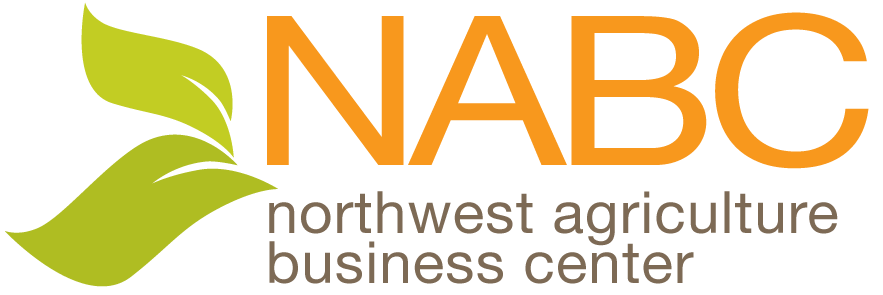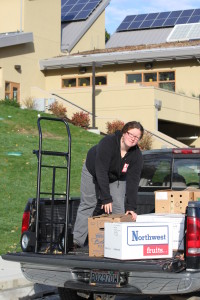Policies and Profits — The Power of Institutional Markets for Farmers
 Washington hospitals are leading the nation in sustainable food procurement. Fresh local food purchasing is good news for patients, doctors, and of course — farmers!
Washington hospitals are leading the nation in sustainable food procurement. Fresh local food purchasing is good news for patients, doctors, and of course — farmers!
After four grueling days in labor with her first child, Kathy Pryor’s best friend gave birth to a beautiful and healthy baby boy. Because of the long and difficult delivery, Mom hadn’t really eaten in days. The nurses recommended a salad or some fruit to begin with — nothing too heavy right away. Kathy looked over the in-patient hospital menu options with her friend, and found mostly burgers and fried food. There was literally nothing available that met the recommendations from hospital staff. Kathy had to drive miles away from the hospital campus to find a meal suitable for her friend, captive in the hospital. When she returned with organic fruit, fresh vegetables, and healthful deli salads from a nearby grocery store the nurses asked, “Wow, where’d you get that?”
This was an experience fraught with irony for Kathy. She works with Health Care Without Harm’s Healthy Food in Health Care initiative helping hospitals replace unhealthy menu offerings with better options. By guiding hospital foodservice staff through goal setting and better sourcing, Kathy helps healthcare institutions serve their institutional missions, and doctors’ Hippocratic oaths to “first, do no harm” more holistically. Given her line of work, she wasn’t surprised by the lack of appropriate options for her friend in the hospital.
A lack of healthful menu options is unfortunately not uncommon at hospitals and other institutions, and in many ways this makes sense. The primary function of institutions like hospitals, universities, senior centers, and childcare facilities is not to feed people. Arguably, these facilities are preoccupied serving their primary mission: treating sickness, educating young adults, and caring for society’s young and elderly.
At the same time it doesn’t seem to make very much sense that healthcare facilities serve food that contributes to the very ailments they treat; that schools from pre-k through college are not serving food to facilitate the best learning; and that senior care programs fail to recognize the role of diet in overall health and wellness in older age. And indeed the tides are changing. More and more (especially with the rise in severity and prevalence of diet-related disease), institutions are paying more and more attention to food.
Kathy currently supports 23 hospitals in Washington who have taken the Healthy Food in Health Care Pledge, as well as others who want to commit to sourcing local and sustainable food for patients and staff, and directing their purchasing power to support healthy food systems. Two Washington hospitals won national awards at CleanMed, HCWH’s national conference, for their efforts and success with these programs. Overlake Hospital Medical Center in Bellevue took second place in the nation in Sustainable Food Procurement, and University of Washington Medical Center (Seattle) took third place nationally in both Sustainable Food Procurement and Food-Climate-Health Connection. In 2011 United General Hospital in Sedro-Woolley earned second place in the nation for their local and sustainable food purchasing. This is all good news for Washington farmers, who are supplying more and more food to area institutions.
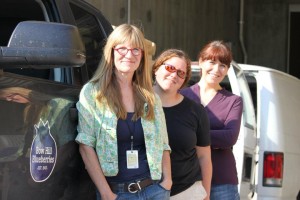 Susan Soltes is one such grower. As owner of Bow Hill Blueberries, she’s been selling transitional organic blueberries to UW Medical Center (UWMC) through the Farm to Table Online Store and 21 Acres Food Hub in Woodinville. The foodservice manager there signed the Healthy Food in Health Care Pledge as part of the hospital’s employee wellness plan. NABC introduced UWMC to Susan and other producers and the hospital continues to scale up its local purchasing.
Susan Soltes is one such grower. As owner of Bow Hill Blueberries, she’s been selling transitional organic blueberries to UW Medical Center (UWMC) through the Farm to Table Online Store and 21 Acres Food Hub in Woodinville. The foodservice manager there signed the Healthy Food in Health Care Pledge as part of the hospital’s employee wellness plan. NABC introduced UWMC to Susan and other producers and the hospital continues to scale up its local purchasing.
Scale of purchasing is one of the most exciting qualities inherent to institutional buying. A typical Seattle area hospital spends $2-3 million on food every year, so to direct that spending towards local producers can be quite meaningful for independent businesses and local economies. Universities are especially interesting in this regard. The public universities in WA spend between $3 and $11 million each, annually. Including private universities, WA colleges and universities spend well over $50 million annually on food. Why not direct at least a portion of that spending to local producers?
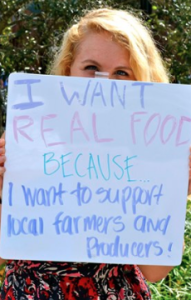 That’s the idea behind the Real Food Challenge, a national initiative to harness the purchasing power of colleges and universities to improve the food system. The goal is to redirect 20% of the national college food expenditure, equaling one billion dollars, towards local and community based, just and sustainable food and farm businesses. In a year and a half since launching the Get Real! campaign, the Real Food Challenge has redirected over $50 million dollars away from industrial agriculture toward more responsible producers. NABC partners with the Real Food Challenge in the Northwest. Western Washington University is close to securing a Real Food policy commitment, which would allocate 30% of the schools food budget towards ‘Real Food’ annually.
That’s the idea behind the Real Food Challenge, a national initiative to harness the purchasing power of colleges and universities to improve the food system. The goal is to redirect 20% of the national college food expenditure, equaling one billion dollars, towards local and community based, just and sustainable food and farm businesses. In a year and a half since launching the Get Real! campaign, the Real Food Challenge has redirected over $50 million dollars away from industrial agriculture toward more responsible producers. NABC partners with the Real Food Challenge in the Northwest. Western Washington University is close to securing a Real Food policy commitment, which would allocate 30% of the schools food budget towards ‘Real Food’ annually.
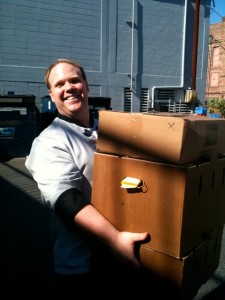 In our efforts to improve the economic vitality of the agriculture industry within northwest Washington, NABC provides farmers and food producers with technical assistance and business services including marketing and sales opportunities. We identified the institutional market early on when we pulled together the Skagit and Seattle Wholesale Markets in 2010 and 2011. The Wholesale Markets were conceptualized as a pick up and pay site for restaurants and other commercial food buyers to source locally. To our surprise, the people who came the most often and bought the most product, were institutional foodservice buyers. Restaurant buyers came and went but hospital buyers stuck around.
In our efforts to improve the economic vitality of the agriculture industry within northwest Washington, NABC provides farmers and food producers with technical assistance and business services including marketing and sales opportunities. We identified the institutional market early on when we pulled together the Skagit and Seattle Wholesale Markets in 2010 and 2011. The Wholesale Markets were conceptualized as a pick up and pay site for restaurants and other commercial food buyers to source locally. To our surprise, the people who came the most often and bought the most product, were institutional foodservice buyers. Restaurant buyers came and went but hospital buyers stuck around.
The trend we saw reflects the greater advantage of institutional markets: institutions are rooted in our communities. Food businesses will come and go, but our institutions like universities, hospitals, and senior care facilities are largely here to stay, and those industries are only growing. Hospitals and Universities (‘Ed and Med’ in the industry) are anchored here. They anchor jobs and revenue in our communities — so why not anchor the funds they spend on food as well?
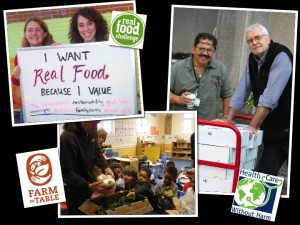 Another advantage to institutional purchasing is that unlike many businesses, institutions are often accountable to institutional policy (such as the Healthy Food in Health Care Pledge, the Real Food Campus Commitment, and the City of Seattle Food Action plan, which has committed resources to support and expand the Farm to Table program, Good Food Bag Program, Summer Feeding Program, Congregate Meal Programs for Seniors — all programs that NABC had a hand in developing.) Institutions answer not only to their bottom line, but to best practices and policies that keep them investing locally.
Another advantage to institutional purchasing is that unlike many businesses, institutions are often accountable to institutional policy (such as the Healthy Food in Health Care Pledge, the Real Food Campus Commitment, and the City of Seattle Food Action plan, which has committed resources to support and expand the Farm to Table program, Good Food Bag Program, Summer Feeding Program, Congregate Meal Programs for Seniors — all programs that NABC had a hand in developing.) Institutions answer not only to their bottom line, but to best practices and policies that keep them investing locally.
Because of such policies, it’s clear that the landscape of institutional foodservice is changing. We even see this reflected in culinary training programs. Lucy Norris, NABC’s Director of Marketing, currently serves cochair of the Seattle Culinary Academy‘s technical advisory committee. The committee is currently developing a bachelors degree in Culinary Nutrition, a program which will prepare developing chefs for jobs in institutional foodservice. Students will learn to prepare not only delicious, but nutritious and sustainably-sourced dishes. These values are becoming the core of the foodservice industry. Now is the time to get ahead of the trend and capture what we can of that market.
Of course there are still barriers to entry for the institutional market, and NABC is working to address those hurdles. To address the large volume needs of institutions, NABC supports the development of producer cooperatives and regional food hubs to aggregate and efficiently distribute product. To address food safety and processing needs, NABC has staff on hand to discuss HACCP plans, GAP certification, and the Food Safety Modernization Act. We are also developing a processing facility. The food hubs we have supported are tied to online market places to make sales connections and transactions more convenient efficient for both producers and buyers. It is possible for producers of all sizes to serve the institutional market.
Foundations interested in food systems development as well as public health are starting to notice this trend as well. The Robert Wood Johnson Foundation has recently funded a project focused on connecting farm to institution. The project will assess the scale of institutional markets in the Seattle area, and identify additional bottlenecks in the food system slowing farm to institution progress. As leaders in the farm to institution market in Washington, NABC and Health Care Without Harm are two of the funded collaborators.
These recent funding opportunities and the national attention WA hospitals are getting indicate that these farm to institution relationships are working. We can see the changes. Virginia Mason Hospital & Medical Center has integrated an organic salad bar into their cafeteria. Overlake Hospital Medical Center is buying hook and line-caught wild salmon for their cafes and patient meals. The direct purchasing relationship with the fisherman makes the high-quality product cost effective for the hospital.
With all this success, what’s next for Kathy and the WA hospitals she works with? As such role models in the sustainable purchasing world, she hopes WA healthcare facilities will go above and beyond the requirements of their institutional policies. “I want people to take what they’re doing with Health Care Without Harm and take it even further; do it even better”, Kathy says. And she has high expectations. “Good-hearted people go into health care. These are people who have a natural interest in nourishing and healing people. Hospital chefs and foodservice staff are people who want to do the right thing; they are people who want to use their hours and years more meaningfully, and make a difference in the lives of others.”
Visit our website to learn more about NABC’s current Farm to Institution programs and history of supporting farm to institution relationships. You can follow NABC, Health Care Without Harm, and the Real Food Challenge Northwest on Facebook.
